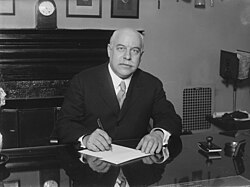Biography:George K. Burgess
George Kimball Burgess | |
|---|---|
 Burgess in 1924 | |
| 2nd Director of the National Bureau of Standards | |
| In office April 21, 1923 – July 2, 1932 | |
| President |
|
| Preceded by | Samuel Wesley Stratton |
| Succeeded by | Lyman James Briggs |
| Personal details | |
| Born | January 4, 1874 Newton, Massachusetts |
| Died | July 2, 1932 (aged 58) Washington, D.C. |
| Nationality | American |
| Alma mater | |
| Scientific career | |
| Fields | Physics |
| Institutions |
|
George Kimball Burgess (January 4, 1874 – July 2, 1932) was an American physicist, considered one of the most notable scientists of his era. He authored and translated numerous studies, was a leading member and president of many scientific societies and, for the last nine years of his life, served as director of the National Bureau of Standards.[1]
Biography
He was born on January 4, 1874, in Newton, Massachusetts, to Charles A. Burgess and Addie L. Kimball. He graduated from the Massachusetts Institute of Technology with a B.S. degree in 1896 and, in 1901, received from the University of Paris his Sc.D. with "very honorable mention", the highest commendation accorded to a doctorate. During his time in Paris, he met and married Suzanne Babut and, following his return to the U.S., served as physics instructor at MIT and at the universities of Michigan and California.[1]
In 1903 he became associate physicist in the National Bureau of Standards, paying particular attention to pyrometric researches. Besides translating Henry Louis Le Chatelier's High Temperature Measurements (1901), and Pierre Duhem's Thermodynamics and Chemistry, he published his 1901 French-language dissertation, Recherches sur la constante de gravitation as well as Experimental Physics, Freshman Course (1902), The Measurement of High Temperatures (with Le Chatelier, 1911; third edition, revised, 1912) and A Micropyrometer (1913). He also served, from 1911, as editor of Journal of the Washington Academy of Sciences. He was renowned as a top expert in metallurgy and, during World War I, developed, with other scientists, multiple instruments for military use, including those designed for camouflage, radio communication and aeronautics. In 1918, Burgess served as president of the Philosophical Society of Washington.[2] In 1923, he became second director of the National Bureau of Standards and held the post until his death.[1]
George Burgess, who was a member of the foreign service as well as a number of government consultative bodies, was in the midst of consultations regarding the ongoing financial crisis when he suffered a fatal cerebral hemorrhage in his Washington, D.C., office and died on the way to Emergency Hospital. He was 58 years old, and was survived by his wife, Suzanne.[1]
References
- ↑ 1.0 1.1 1.2 1.3 "Dr. Burgess Dead. Famous Scientist. Director of U.S. Bureau of Standards Stricken While Conferring on Economy. Worried For Associates. Metallurgist of First Rank. Paved Way for High-Temperature Tests. An Author of Note". New York Times. 3 July 1932. https://query.nytimes.com/gst/abstract.html?res=9C05EFDC113EE633A25750C0A9619C946394D6CF.
- ↑ "Past Presidents" (in en). https://pswscience.org/about-psw/past-presidents/.
Further reading
- Annual Report of the National Academy of Sciences, 1932: In memoriam Dr. George K. Burgess
- [1] Briggs, Lyman J. and Brode, Wallace R. (1957). George Kimball Burgess, a Biographical Memoir. Washington, D.C.: National Academy of Sciences.
 This article incorporates text from a publication now in the public domain: Gilman, D. C.; Peck, H. T.; Colby, F. M., eds (1905). "article name needed". New International Encyclopedia (1st ed.). New York: Dodd, Mead.
This article incorporates text from a publication now in the public domain: Gilman, D. C.; Peck, H. T.; Colby, F. M., eds (1905). "article name needed". New International Encyclopedia (1st ed.). New York: Dodd, Mead.
External links
| Government offices | ||
|---|---|---|
| Preceded by Samuel Wesley Stratton |
Director of the National Bureau of Standards 1923 – 1932 |
Succeeded by Lyman James Briggs |
 |

